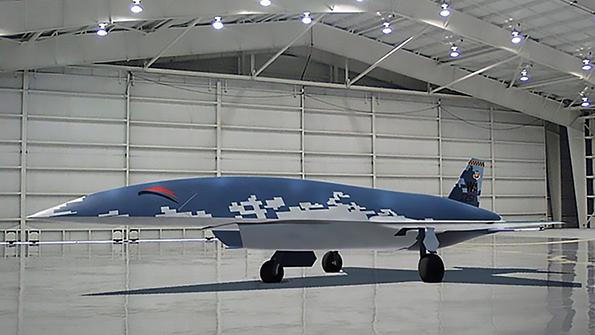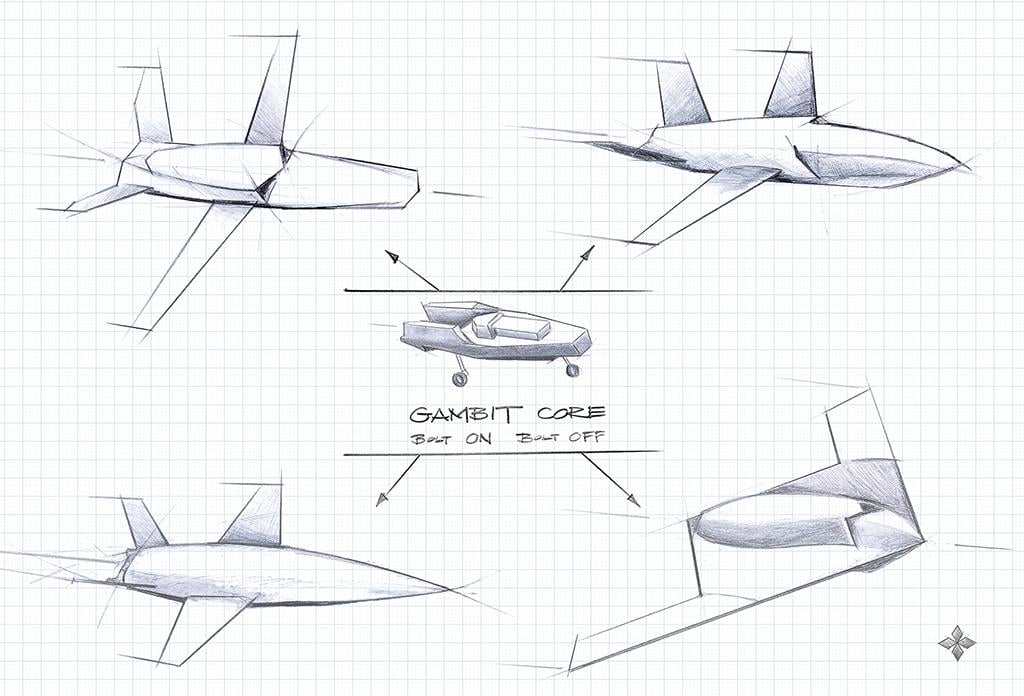
Three distinct classes of aircraft piloted by artificial intelligence have emerged as options to fly alongside current and future U.S. Air Force fighters. The candidates range from expendable to exquisite systems, with a potential middle tier of attritable aircraft that leverage modular design features inspired by the automotive industry.
All of these concepts were on full display inside the exhibit hall of the Air Force Association’s annual Air, Space and Cyber Conference, which celebrated the 75th anniversary of the founding of the Air Force as an independent branch of the military.
- Exquisite, attritable and expendable options shown
- “Bolting on” more capability
On the high end, Northrop Grumman’s booth featured a concept model of the SG-101, the latest example of the company’s long line of advanced flying-wing aircraft. Lockheed Martin, meanwhile, showed off the Skunk Works’ concept for the Speed Racer, an expendably cheap uncrewed aircraft system (UAS) that will soon be teamed with F-35s for a demonstration called Project Carrera.
For the first time, General Atomics Aeronautical Systems Inc. (GA-ASI) and Kratos executives talked about their competing and similar proposals for a middle layer of Air Force Secretary Frank Kendall’s vision of so-called Collaborative Combat Aircraft (CCA) (see page 22). GA-ASI’s Gambit and Kratos’ Demigorgon would be families of UAS in the 10,000-lb. class that share a common chassis—consisting of a keel, landing gear, power systems, mission computer and avionics—but integrate different airframes, wings, inlets, engines and payloads depending on the mission.
Boeing’s exhibit booth at the Air Force event showed off images of the Australian-built MQ-28 Ghost Bat UAS. Instead of swapping airframes and engines for different missions, the MQ-28 would be fitted with different nose-mounted radomes to accommodate different payloads. Finally, Blue Force Technologies, a small, North Carolina-based company, displayed a model for the first time of the Fury UAS, which the Air Force is building to demonstrate as an artificial-intelligence (AI)--piloted adversary air platform. The Fury also offers a removable nose section to accommodate different payloads.
All of these concepts are being advertised as Air Force leaders are still far from describing specifically what they are seeking in one or many types of CCA. Although the Air Force is preparing to launch a program of record for the CCA in the fiscal 2024 budget, service leaders do not know exactly what capabilities for an AI-piloted CCA would be possible by a desired fielding date in the early 2030s nor how many such aircraft would be needed overall or per squadron.
Amid this uncertainty, Gen. Mark Kelly, head of Air Combat Command (ACC), advises industry officials to adopt a design philosophy that maximizes flexibility.
“If I was doing a clean-sheet design, I would look for something you can iterate,” Kelly told reporters during the conference.

The Air Force would like a CCA that can fly with an X-band radar one day and, for example, a jammer the next, Kelly said. The aircraft also should be capable of “bolting on” more capability in terms of payload capacity and range.
“I would not lock myself into a sensor that can’t do anything else or a jammer that can’t do anything else,” Kelly said. “If we lock ourselves into [requirements that] ‘it must be this big, it must go this far, it must do these jobs, it must be this price point’ and race to the finish line, we might find out we’re wrong, and we’re going to turn around and go back and start again.”
Instead, the Air Force prefers an iterative approach to CCA development, prizing aircraft designs that can adapt as the capabilities of AI-piloted systems are understood, even as they continue rapidly evolving.
Air Force leaders are still developing a business case for the CCA program, and they have not decided whether the requirement will call for a single aircraft type or a family of multiple aircraft.
“That’s something we need to figure out over time,” Andrew Hunter, assistant secretary of the Air Force for acquisition, technology and logistics, told reporters during the conference.
In the meantime, the Air Force also understands nontechnical obstacles to fielding a CCA must be addressed, such as performing tasks as part of a team with crewed fighters. The Air Force has operated a fleet of GA-ASI MQ-9A and Northrop RQ-4B UAS for decades but largely in a stand-alone role. On the other hand, the CCA would be linked directly to crewed fighters and bombers in combat.
“I think it’s also fair to say that the history of this effort shows that it takes strong leadership support to overcome the cultural barriers that are sometimes there when it comes to uncrewed aircraft,” Hunter says.
ACC plans to address the cultural issues by introducing AI-piloted aircraft first as adversary air (ADAIR) platforms. In March 2021, Blue Force Technologies was selected to build four Fury aircraft for the ADAIR--Unmanned Experimental (ADAIR-UX) demonstration, also known as the Bandit program. If the demonstration is successful, a follow-on production program is possible.
The goal of the ADAIR-UX program is to make Air Force pilots comfortable operating alongside AI--piloted aircraft in the same airspace—in a relatively safe environment. The adversary air mission at Nellis AFB, Nevada, for example, is performed in highly restricted airspace, with aircraft playing the role of a “target” for beyond-visual--range intercepts in designated blocks of airspace. As human pilots become more comfortable with the behavior and capability of the AI--piloted UAS, they may be able to start conducting combat-training missions as collaborative teams.
Blue Force Technologies, which proposed the ADAIR-UX concept to ACC as part of a small-business innovation research project, plans to compete for the production program but will likely face competition from much larger companies.
Michael Atwood, GA-ASI’s technical director of advanced programs, told Aviation Week during the conference that his company is “extremely interested” in competing for the ADAIR-UX production order with a new variant of the Gambit family of UAS. Likewise, Steve Fendley, president of the Kratos Unmanned Systems Division, told Aviation Week that his company would offer the roughly 10,000-lb.-class Demigorgon UAS for the program.

